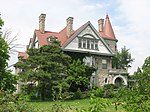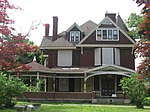Avondale, Cincinnati
1967 in Ohio1967 riots1968 in Ohio1968 riotsAfrican-American history in Cincinnati ... and 5 more
African-American riots in the United StatesFormer municipalities in OhioKing assassination riotsNeighborhoods in CincinnatiRiots and civil disorder in Cincinnati

Avondale is a neighborhood in Cincinnati, Ohio. It is home to the Cincinnati Zoo and Botanical Garden. The population was 12,466 at the 2010 census.92 percent of Avondale residents are African American and more than 40 percent are living at or below the poverty level. More than 77 percent rent housing. Two civil rights protests began in Avondale in 1967 and 1968, which were part of the larger Civil Rights Movement and Black Power movement in the United States. The neighborhood is bordered by North Avondale, Evanston, Walnut Hills, Corryville, and Clifton.
Excerpt from the Wikipedia article Avondale, Cincinnati (License: CC BY-SA 3.0, Authors, Images).Avondale, Cincinnati
Washington Avenue, Cincinnati Avondale
Geographical coordinates (GPS) Address Nearby Places Show on map
Geographical coordinates (GPS)
| Latitude | Longitude |
|---|---|
| N 39.147777777778 ° | E -84.495 ° |
Address
Washington Avenue 3588
45229 Cincinnati, Avondale
Ohio, United States
Open on Google Maps










